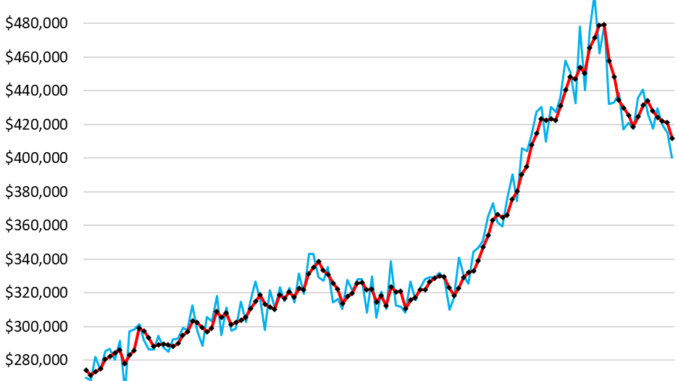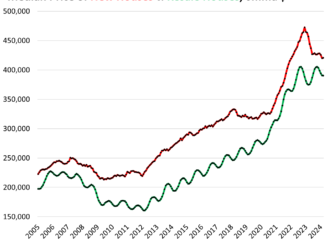
Prices of New Houses v. Existing Houses: Price cuts and mortgage-rate buydowns make new houses more attractive.
By Wolf Richter for WOLF STREET.
The median price of new single-family houses that were sold in February fell to $400,500, the lowest since June 2021, down by 7.6% from February 2023 and down by 6.3% from February 2022, according to data from the Census Bureau today (blue in the chart). Compared to the peak in October 2022, the median price has dropped by 19.4%.
The three-month moving average, which irons out some of the monthly ups and downs, fell to $411,700, the lowest since September 2021 (red).
The prices here do not include the substantial costs of mortgage-rate buydowns that homebuilders use to stimulate sales in this market where sales of existing homes have plunged. Mortgage-rate buydowns lower the monthly payment but do not lower the contract price of the house. Prices here also don’t include other incentives, such as free upgrades. These contract prices show that homebuilders are building smaller homes with less expensive amenities at lower price points, and then they’re throwing mortgage-rate buydowns and other incentives on top of it to make deals.
Lower the price and they will come.
Homebuilders sold 60,000 new houses in February, not seasonally adjusted, up a tad from January, and up by 7.1% from a year ago.
Compared to February 2019, sales were down only 4.8%, despite the 7% mortgage rates, while sales of existing (resale) homes plunged by 19% compared to February 2019.
The fact that sales of new houses are hanging in there despite 7% mortgage rates shows that homebuilders have figured out this market, and they’re running circles around homeowners trying to sell. Homebuilders are competing directly with resale homes. They’re in the business of building homes, and they cannot try to outwait this market, as many potential home sellers are trying to do.
Additional competition from the multifamily construction boom.
Over the past few years, multifamily building construction – condos and apartments, mostly at the higher end – has started to put a large number of units on the market. In 2022 and even in 2023, multifamily construction starts were at the highest since the 1980s.
This plays into the trend of population growth. As cities get larger, they get denser as some people choose to live in larger buildings at the core of the city with shorter commutes. Time is money. And money is money too, because people can save money on a monthly basis. People are doing this calculus, and they’re making choices.
This is the competition for single-family houses, both new and resale, and people are arbitraging the cost differences:
Price difference between new and resale houses.
Homebuilders are aggressively taking sales away from homeowners, as the largest homebuilders have explained in their earnings calls. And the price difference between new and resale single-family houses has narrowed in a historic manner.
The national median price of new single-family houses (Census Bureau) has fallen faster and further than the national median price of resale single-family houses (National Association of Realtors).
We’re going to use 6-month moving averages in our comparison to smoothen out the strong seasonality of the median price of resale houses (seasonal high in June, seasonal low in January) and the volatile but not seasonal prices of new houses.
Red denotes the median price of new houses, green the median price of resale houses. We’re going to look at the percentage differences in a moment, which are even more illuminating.
In percentage terms, the median price (6-month moving average) of new houses is now only 6.6% higher than the median price of resale houses. The difference has been in the same range for the past nine months.
If you figure in the effects of mortgage-rate buydowns, the payments on a new house can be less than the payments on an equivalent resale house.
The unusual narrowing price difference – as homebuilders lower their prices more quickly than homeowners – also happened in the leadup to the Housing Bust and lasted well into the Housing Bust. Prices of resale homes eventually fell so much they became competitive with new houses again toward the end of the Housing Bust in 2012.
Inventory for sale is very ample.
In February, there were 456,000 new houses for sale at all stages of construction (not seasonally adjusted). Inventory has been in this very high range for months. In February, this inventory translated into 7.8 months of supply, which is more than ample, and a reminder that builders are very motivated to make deals:

